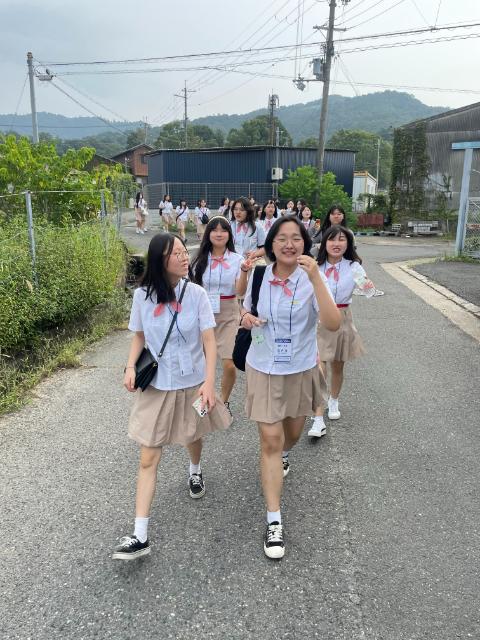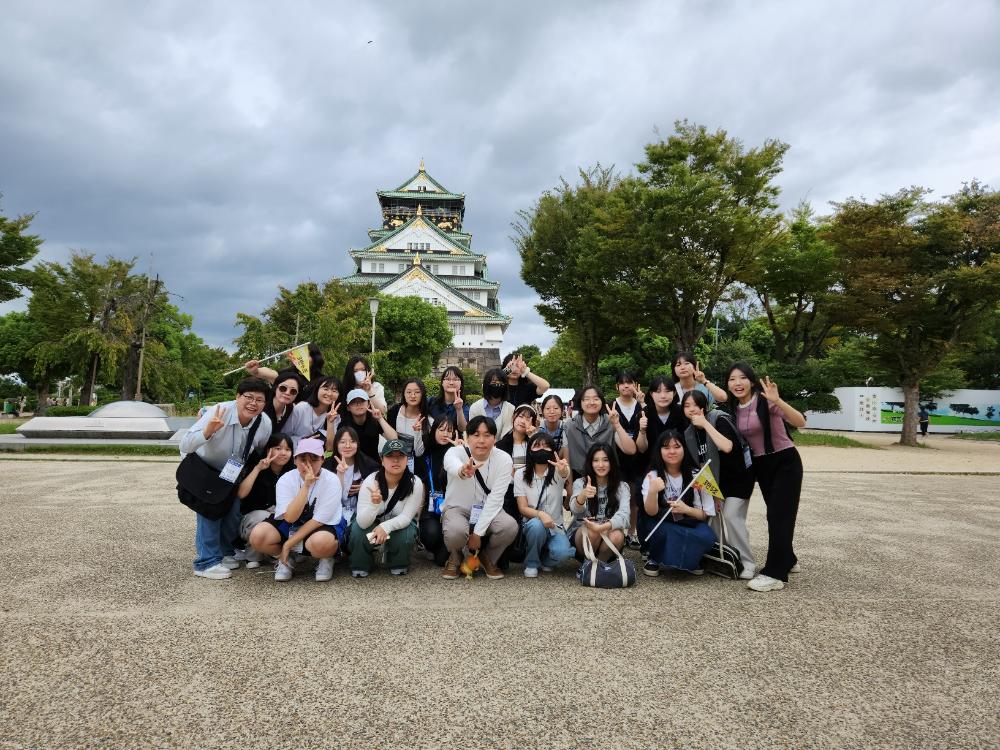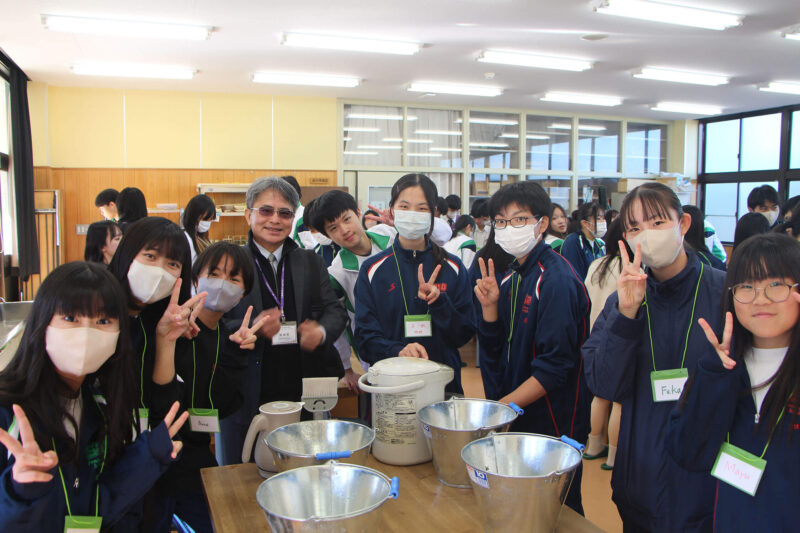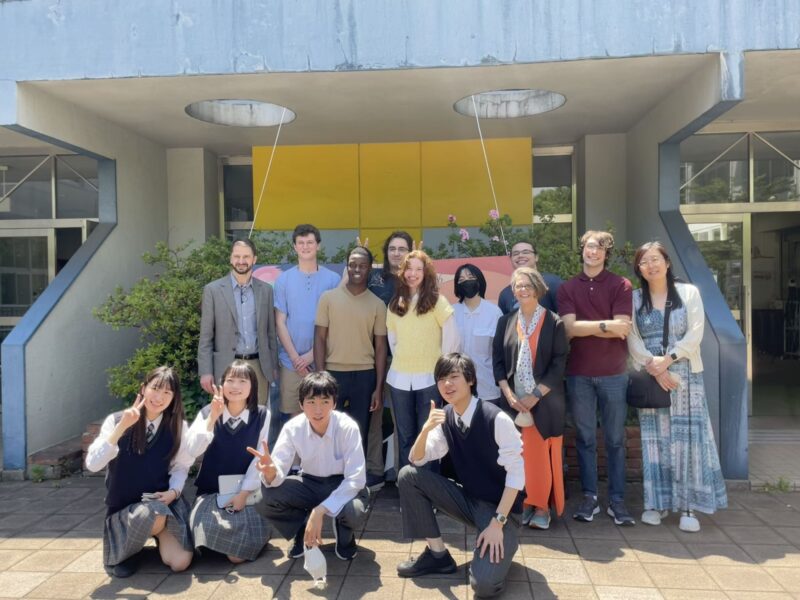
Hanlim Art & Design High School , South Korea, participated in a school exchange with Nara Prefectural Takamado Senior High School . Kim Hee Ju (16), a student of the high school, and teacher Cho Eun Hye share their experiences such as interactions with fellow art students and the flower arrangement program. Ms. Cho delves into the planning and preparations for the trip and shares advice for those considering educational travel and school exchange programs in Japan.
Hee Ju’s school exchange experience

A fascination with Japan inspired by her father
My father graduated from a university in Japan, so I always had an interest in the country and wanted to learn more about it. I have practiced Japanese by talking with my father, and also learned the language from Japanese friends I met on social media. Recently, I’ve been reading manga and novels to learn kanji characters. For instance, I read the manga Haikyu!! and Osamu Dazai’s novel No Longer Human.
To prepare for this trip to Japan, I looked into and practiced Japanese etiquette, manners, greetings, and honorifics. Korean also has honorifics, but there are so many different types of honorifics in Japanese that it’s difficult to translate them. I learned Japanese mainly from conversations through social media sites and games, rather than studying textbooks.
Moved by school song played with Japanese musical instruments
When we visited Nara Prefectural Takamado Senior High School, we were surprised to hear the school song of Hanlim Art & Design High School played on traditional Japanese musical instruments at the welcome ceremony. I have listened to traditional Japanese music before, but hearing our school song played with those instruments was such a moving experience.
In the first part of the exchange program, after being shown drawings and photos by the Japanese students, we were divided into small groups to play a word game using pictures drawn on the spot. I was nervous at first, but everyone was kind and explained the rules slowly so that I—a visitor from abroad—could understand. I also tried ikebana for the first time. It was such a valuable opportunity for me to learn about Japanese traditional culture that I was previously unfamiliar with.
Noticing how thoughtfulness pervades Japanese culture
I love traditional Japanese aesthetics and think that it’s wonderful that there are so many historical buildings still standing. . The façade has these soft colors that you don’t see in Korean architecture. I could not stop staring at it. Next time, I hope to visit the Akihabara neighborhood and Disneyland.

For me, the most memorable part of this educational travel program was the school exchange. We spent a lot of time listening in the classes and would have liked to have more time to speak Japanese, but I’m glad I got to talk to Japanese students around the same age who are studying in an art school just like me. It was an incredibly precious experience.
I was also impressed that Japanese schools are very active in after-school club activities, ranging from arts to sports. Korean high schools also have club activities, but they’re not taken as seriously as they are in Japan. Hearing the gentle way Japanese students speak to each other warmed my heart.
Honorifics were a challenge for me, but I was able to learn the appropriate expressions by observing how they are actually used in different situations, such as when walking down a crowded street or talking to a sales clerk in a store. Having had the opportunity to experience real-life communication in Japanese has given me confidence in my language skills, and at the same time, it has encouraged me to study Japanese even more. I feel that Japanese culture places an emphasis on consideration for others in its honorifics, greetings, and manners. In the future, I hope to attend a Japanese university and learn more from Japanese culture.
Interview with faculty

Eunhye Cho, teacher
Ms. Eunhye Cho has been teaching for two years. She works at Hanlim Art & Design High School, Chungju, South Korea, where she specializes in music and is currently in charge of a first-year class.
Q. Why did you select Japan as your educational travel destination?
A. The city of Chungju has begun supporting the cost of educational travel abroad as part of its global education support program for high school students, and we decided to implement the program at our school. We selected Japan, China, and Taiwan as potential destinations that could be traveled within the budget range, and after surveying students and their parents, 70 to 80% of them chose Japan. Many of our students study art and design, so they have an interest in Japan, which is home to the world’s largest animation and manga market.
Q. Tell us about the participating students.
A. All our first-year high school students participated in this educational travel program to Japan. They are all in the same grade, but each class specializes in a different field, studying each of the following five: illustration/painting, 3D imaging, beauty, fashion, and business economics.
Q. Tell us about your destination cities and why you picked them.
A. An exchange with a Japanese school was our top priority, so we asked the travel agency to ensure to include it in our itinerary. We also wanted to exchange with an art high school, just like us. The travel agency suggested this school based on our requests.
We were scheduled to stay for four nights and five days, so we decided to visit three cities: Osaka, Nara, and Kyoto. We wanted to avoid traveling long distances from Nara Prefecture, where the school exchange was to take place. Incorporating advice from the travel agency, we chose places that have deep connection with Korea, such as Doshisha University, where the Korean poet Yun Dong-Ju studied. We also visited Dotonbori and Universal Studios Japan, where we could get a sense of modern-day Japan. In Kyoto, we visited Byodoin Temple and the Garden of Fine Arts Kyoto by Tadao Ando.

Q. How did the students prepare for the educational travel program?
A. In my homeroom class, we had weekly inquiry-based activities about Japan. The class was divided into five groups that delved into themes such as music, fashion, history, and culture, and gave presentations about these topics. After returning to Japan, I will ask them to submit a report comparing their prior studies with their actual experiences there.
They also practiced the theme song from the Studio Ghibli film Spirited Away, “Always With Me” in Japanese so that they could sing it at the welcome ceremony. I selected the song since I’m the music teacher. It’s a memorable track for me as it was pretty popular back when I lived in Tokyo for my father’s work.
Q. Tell us about the school exchange program.
A. For the exchange program, I requested the school to arrange activities where the students could paint together or get to know traditional Japanese culture if possible. I was so impressed with the range of programs they had prepared such as tea ceremony, flower arrangement, calligraphy, and Japanese musical instruments. For communication, we used translation apps and an interpreter was assigned to each classroom.
What left a big impression on me was the cheerful greetings and bright expressions of the students of Nara Prefectural Takamado Senior High School. Students from other grades who passed us in the hallway also greeted us with such warmth and made us feel welcome. We could see that they had meticulously prepared for the visit by having enough students to show us around and help us during the classes.
I found the explanations about flower arrangement fascinating. Since it was autumn, they used chrysanthemums and other seasonal flora. They told us about the symbolism behind each flower, such as how the tallest flower represents the sky. I felt that it was a great example of Japanese culture. We were provided with a printout of the explanation translated into Korean, which made the process smooth and easy to understand.
Q. Would you like to do school exchanges in Japan again in the future?
A. In a student survey conducted after our return, when asked what was the most memorable part of their stay in Japan, the school exchange with Takamado Senior High School topped the list. We, the faculty, agree. Our educational travel program would not have been as meaningful without this exchange. Although there are some financial issues, such as the availability of support from the city, we would like to continue these exchanges in the future. I believe that actually going out, having new experiences, and talking about design and art with students of the same age is very important. It’s the kind of education you don’t get in regular classes.
Q.Finally, what advice would you give to those who are considering education travel or school exchanges in Japan?
A. In my class, we had a total of four hours of inquiry-based activities about Japan prior to the trip, but I don’t think that was enough. If we had had more time, we would have been able to find new perspectives as we experienced various new things in Japan. Similarly, it would’ve been ideal if we had about the span of a year to communicate with the travel agency and the coordinator on the Japanese side. Since there are language and distance issues, it’s difficult to meet and discuss in person beforehand, so it will inevitably take more time to make decisions compared to a domestic trip.
School Exchange Overview
| Visiting School | Hanlim Art & Design High School(South Korea) open_in_new |
|---|---|
| Host School | Nara Prefectural Takamado Senior High School (Nara) open_in_new |
| Date | 20th September in 2023 |
| Main Exchange Programs | Intercultural Exchange, International Exchange |
| Age of Participating Students |
Hanlim Art & Design High School :
17 years old
Nara Prefectural Takamado Senior High School :
15 to 18 years old
|
| Number of Participants |
Hanlim Art & Design High School :
189 people (
171 students, 18 teachers)
Nara Prefectural Takamado Senior High School :
270 people (
240 students,
30 teachers)
|
Educational Travel Overview
| Itinerary | 19th - 23th September in 2023 |
|---|---|
| Main Destinations | Nara, Osaka, Kyoto, |



